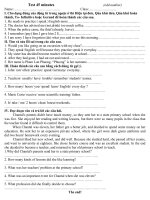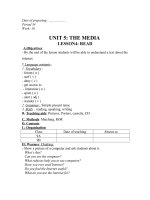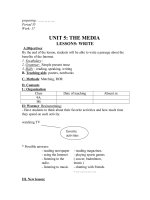TÀI LIỆU TIẾNG ANH NGÀNH MAY - ĐỊNH NGHĨA MỘT SỐ LOẠI VẢI - Fabric definitions textile document
Bạn đang xem bản rút gọn của tài liệu. Xem và tải ngay bản đầy đủ của tài liệu tại đây (108.89 KB, 8 trang )
Fabric Definitions
Acrylic - A manufactured fiber in
which the fiber-forming substance is
any long chain synthetic polymer.
(Meaning to the consumer: weather-
resistant)
Batiste - Originally named for John
Baptiste, a French weaver. It is a sheer
silk like fabric, either plain or figured,
similar to silk mull. Can be woven from
cotton where it is a sheer, fine combed,
mercerized muslin characterized by
wide streaks in construction, and can also be made of wool or worsted yarns in a smooth
fine fabric that is lighter than challis. Also can be made of spun rayon or other fibers.
Brocades - Rich Jacquard-woven fabric with all-over interwoven designs of raised
figures or flowers. Name derived from French meaning to “ornament.” Often gives an
embossed appearance by contrasting surfaces, colors, and gold or silver threads on satin
or twill grounds. Made in many weights for apparel and decorative fabric uses.
Boucle - Knitted or woven fabric with characteristic looped or knotted surface that often
resembles a spongy effect. Term also applies to a variety of looped, curled, or slubbed
yarns. In French “boucle” means “buckled” or “ringed”.
Broadcloth - Tightly wove lustrous cotton cloth with fine imbedded cross-wide ribs that
resemble poplin. Ribs are finer than those in poplin and broadcloth has more picks.
Newest versions today combine yarns blended with polyester and other man-made fibers.
Burlap - Coarse, canvas-like fabric usually made of jute, but can be made of hemp, or
cotton. Sometimes called gunny. Used primarily for bale coverings and sacks and bags.
Also used in furniture, drapery, wall coverings, and clothing.
Burn-out - A process of printing which uses chemicals, rather than color, to burn out or
dissolve away one fiber in a sized clothed. Purpose is to achieve a sheer lacy and heavy
design. Also used to obtain eyelets or other type holes in a fabric.
Cellulose - A white naturally occurring carbohydrate polymer found in organic woody
substances of most vegetation. It is basic raw material needed for production of rayon and
acetate fibers. About 96 percent of cotton is cellulose.
Cheesecloth - Plain woven soft, fragile, low-count cotton fabric similar to tobacco cloth
and also known as gauze. When bleached and starched it is called scrim.
Chenille - A fuzzy yarn whose pile resembles a caterpillar. Used mainly for decorative
fabrics, embroidery, tassels, and rugs. Sometimes used broadly to define a fabric woven
from chenille yarns.
Chintz - Glazed cotton fabric often printed with figurative and large flower designs.
Named from Hindu word meaning spotted. Some glazes wash out in laundering but
others such as resin finishes are permanent. Unglazed chintz is called cretonne. Used
mainly for draperies, and slipcovers.
Corduroy - A cut filling pile-cloth with narrow to wide wales which run in the warp
direction and made possible by use of an extra set of filling yarns in the construction. The
back is of plain or twill weave.
Cotton - Soft vegetable fiber obtained from the seed pod of the cotton plant and one of
the major fashion fibers in the textile industry. The origin dates back to 3,000 B.C. The
longer the fiber the better the quality.
Crepe - A variety of lightweight fabrics characterized by a crinkly surface obtained
either via use of hard twist yarns, chemical treatments, weave, construction or some form
of embossing or surface treatment. Crepes are available in an unlimited variety of fibers
and blends and in many different constructions.
Damask - Firm, glossy Jacquard-patterned fabric brought to the Western world by Marco
Polo in the 13th century. Damascus was the center of fabric trade between East and West,
hence the name. Damask is similar to brocade but flatter and reversible. Used mainly for
curtains, draperies and upholstery.
Denim - This basic cotton cloth- first brought to America by Columbus almost 500 years
ago
Duck - The name duck covers a wide range of fabrics. It is one of the most durable
fabrics made. A closely woven, heavy material. The most important fabrics in this group
are known as number duck, army duck, and flat or ounce duck. Number and army ducks
are always of plain weave with medium or heavy ply yarns army ducks are the lighter.
Once ducks always have single warp yarns woven in pairs and single or ply-filing yarns.
Generally of ply yarns in warp and yarns of various sizes and weights in filling.
Faille - A lightweight ribbed silk or rayon cloth with crosswise rib effect. It is soft in feel
and belongs to the grosgrain family of cross-rib materials. Has good draping effects, and
will be good to you if you treat it the same.
Frise - Sometimes known as Cotton Frieze, the material is used in the upholstery trade. It
is usually made with uncut loops and is sometimes styled by shearing the loops at varying
heights.
Gauze - Thin, sheer-woven cotton, wool, silk, or synthetic fabrics, similar to cheese
cloth, used primarily for surgical dressings.
Hand-spun - Yarns which are spun by hand, or fabrics made from such yarns.
Heat Transfer - The technique of printing fabrics by transferring printed design from
paper to fabric via heat and pressure. It’s derived from the art of decalcomania which is
the process of transferring pictures or designs from specially prepared paper to other
materials such as glass.
Interlining -A lightweight, napped, cotton, wool, or other fabric used in tailoring for
extra weight or warmth.
Iridescent Fabrics - Changeable effects noted in some cloths because of the color
arrangement in the warp and filling yarns used to provide contrast and interest. Ex:
Taffeta and comparable cloths which show these varying tints and hues as rays of light
strike the goods.
Jacquard – Intricate method of weaving invented by Joseph J.M. Jacquard in the years
1801-1804, in which a headmotion at the top of the loom holds and operates a set of
punched cards, according to the motif desired. The perforations in the cards, in
connection with the rods and cords, regulate the raising of the stationary warp thread
mechanisms. Jacquard knitting is a development of the Jacquard loom and its principles.
Jacquard fabrics, simple or elaborate in design, include brocade, brocatelle, damask,
neckwear, evening wear, formal attire, some shirtings, tapestries, etc.
Lamé - Brocade, brocatelle or damask in which metallic (laminated) threads or yarns are
interspersed throughout the fabric or one in which these threads have been used in the
base construction.
Latex - A paint-like liquid with a viscid, milky, complex emulsion of proteins, alkaloids,
starches, resins, and other substances secreted by the cells of certain plaints such as the
milkweed, rubber tree, and poppy. The liquids extrude from the rubber tree, when the
bark is cut, may be coagulated with lactic acid and compressed into sheets, or solidified
into rubber.
Linen - Derived from a plant called flax. The term, linen, cannot be used except for
natural fiber flax. Its properties include rapid moister absorption, fiber length of few
inches to one yard, no fuzziness, does not soil quickly, and stiffness.
Linen Damask - single damask is made on a five-shaft satin weave double damask is
made on an eight-end satin construction. All damask is made on Jacquard looms. This
very reversible fabric is very durable the higher the texture the better the quality. Damask
will launder well, retain luster and may be all linen, or all cotton, or a union material like
linen filling.
Madras - One of the oldest staples in the cotton trade, it is made on plain-weave
background which is usually white stripes, cords, or minute checks may be used to form
the pattern. Fancy effects are often of satin or basket weave, or small twill repeat. White
filling is used.
Matelassé - A rather soft, double cloth or compound fabric which has a quilted surface
effect. Made on Jacquard looms, the heavier constructions are used for coverlets,
draperies, and upholstery. Lighter weight fabric finds use in dress goods, evening wear,
and trimming. Gives effects such as blistered, puckered, quilted or wadded depending on
the cloth constructions used.
Mesh - Any fabric, knitted or woven, with an open texture, fine or coarse.
Mohair - The long, lustrous and strong hair of the Angora goat. Angora goats are
believed to have originated in the Himalaya Mountains of Asia. The U.S., South Africa,
and Turkey are the three largest mohair producers of the world.
Moiré, watermarked - A finish given to cotton, silk, acetate, rayon, nylon, etc. where
bright-and-dim effects are observed. This popular finish is achieved by passing the fabric
between engraved rollers which press the particular motif into the goods causing the
crushed and the uncrushed parts to reflect light differently.
Muslin - Used generally, but mostly associated with white goods finish print cloth or
sheeting that has been given a pure starched or backfilled finish to provide a dull,
“clothy” effect and hand. Muslin gray goods are finished in fabrics such as batiste,
cambric, chintz, cretonne, lawn, longcloth, mercerized goods, plain muslin, nainsook,
organdy, percaline etc…
Nainsook - A fine, soft cotton fabric, with a plain weave.
Ombre - A graduated or shaded effect of color used in a striped motif. Usually ranges
from light to dark tones of one color creating a monotone rainbow look.
Organza - Usually a very thin, but stiff plain woven silk fabric that resembles organdy.
Ottoman - Silk or man-made-fiber yarn fabric characterized by a heavy, large, rounded
cord effect in the filling direction of the goods.
Pick - A filling thread or yarn that runs crosswise or horizontally in woven goods. The
pick interlaces with the warp to form a woven cloth. See weft.
Pile Fabric - One in which certain yarns project from a foundation texture and form a
pile on the surface. Pile yarns may be cut or uncut in the fabric. Corduroy and velveteen
are ex.’s of cut filling pile fabrics velvet is an ex’s of a cut warp pile fabric while terry
cloth is an ex. of an uncut pile material.
Pique - Medium weight or heavy fabric with raised cords that run in the warp direction.
This substantial cloth is made on dobby, Jacquard, drop-like box and other types of
looms.
Plaid - A pattern consisting of colored bars or stripes which cross each other at right
angles, comparable to a Scottish tartan
Polyester - A manufactured fiber in which the fiber forming substance is any long chain
synthetic polymer composed of at least 85% by weight of an ester of a substituted
aromatic carboxylic.
Poplin - A broad term to imply several fabrics made from various types of yarn.
Identified by a fine rib effect in the filling direction from the selvage to selvage. Plain
weave is used with the rib effect made by the use of a warp yam much finer than the
filling yarn with a texture or count of two or three times as many ends as picks in goods.
Primary colors - Red, blue and yellow, and from these colors other colors are made.
These are the only colors you can not mix any other color with another to achieve. It must
be created in its pure form via chemical or found in nature.
Pucker - The uneven surface caused by differential shrinkage in the two layers of a
bonded fabric during processing, dry cleaning, or washing.
Rayon - A manufactured fiber composed of regenerated cellulose in which substitutes
have replaced not more than 15% of the hydrogen. Often a stiffer and more difficult to
keep wrinkle-free fabric.
Rib - Usually a straight raised cord, formed in a weave by threads which are heavier than
the others, lengthwise, crosswise, or diagonal. Many knitted fabrics are ribbed
lengthwise.
Sailcloth - Any fabric use for sails. Usually a heavy and strongly made canvas of cotton,
linen, jute, polyester or nylon.
Scrim - An open mesh, plain-weave cotton cloth made from carded or combed yarns in
several constructions and weights for use as bunting, buckram, curtains, etc. Can also be
light weight cotton sheer cloth made in doup or in plain weaves with single-ply yarns.
Often made with colored checks or stripes and serves as curtaining.
Seersucker - Lightweight cloth made of cotton, nylon, silk, and in blends of these fibers.
Two warps are used a base warp which lies flat in goods and warp that becomes crinkled
in while the other one weaves “slack”. Note: Plisse is a simulated seersucker and is not
durable whereas seersucker is.
Shantung - A silk fabric very similar to but heavier than pongee. Contains the trademark
“slubing” typical in raw silk. Originally woven of wild silk in Santung, China, and is now
often made with synthetics or mixtures.
Sheer - Any of a group of very thin cloths such as chiffon, batiste, net, organdy, and
voile. It is typically transparent.
Silk - The only natural fiber that comes in a filament form, from 300-1600 yards in
length as reeled from the cocoon, cultivated or wild. (ABOUT SILK: The threads are
“harvested” from the silkworm when it begins its spinning. Two filaments are emitted
from the “silk ducts” which are covered by silk gum or sericin from the sacks before they
come from the mouth of the silkworm. The liquid is emitted by the silkworm, and
solidifies on contact with the air. A single filament is called “brins”. The two filaments
are by this time are solidified together by the silk gum or sericin, and is now called
“fibron” or silk.
Single Damask - Silk fabric which has the ground and the motif weave or weaves made
on a five-shaft satin weave. The double damask is made on the eight-harness satin weave,
and would not have the short floats noted in the single damask construction which gives
better service. Also made in linen, rayon, and mixture fabrics.
Slub Yarn - Yarn of any type which is irregular in diameter may be caused by error, or
purposely made with slubs to bring out a desired effect and to enhance a material.
Slub - Defect looking nubs caused by bunching of the threading while weaving. Defects
are with the weave of the fabric.
Strie - Said of cloth which has irregular stripes or streaks of practically the same color in
the background. Each yarn in the motif is dyed a solid color, runs in the warp direction of
the goods, and produces a mottled effect.
Suede Fabric - Woven or knitted cloth made from the major textile fibers and finished to
resemble suede leather.
Taffeta - A fine plain weave fabric smooth on both sides, usually with a sheen on its
surface. Named for Persian fabric taftan. May be solid colored or printed, or woven in
such a way that the colors seem “changeable”.
Tapestry - Originally ornamented Oriental embroideries in which colored threads of
wool, gold, silk, or silver were interspersed for adornment. At present, tapestry is mostly
power-loomed on dobby looms. Hand woven tapestry however, is still being made.
Ticking - Compactly woven cotton cloth used for containers, covers for mattresses and
pillows, sportswear (hickory stripes), institution fabric, and work clothes. It is striped
cloth, usually white background with blue or brown stripes in the motif.
Tissue - The lightweight versions of fabrics such as batiste, chambray, crepe, dimity,
faille, gingham, organdy, taffeta, voile, etc., are known by this term.
Toile - General Term used in France to designate vegetable fiber cloths made on plain or
twill weaves, especially hemp and linen materials. Some sheer cotton and linen materials
are called toile.
Tweed - A rough, irregular, soft and flexible, unfinished shaggy woolen named for the
Tweed River which separates England from Scotland. One of the oldest and most popular
outerwear fabrics used today. It is made of a two-and-two twill weave, right hand or left-
hand in structure. The term is now used rather loosely being given too many town and
country fabrics.
Twill Weave - Identified by the diagonal lines in the goods. It is one of the three basic
weaves, with the others being satin and plain. All weaves, simple, elaborate or complex,
are derives from these three weaves.
Velvet - A warp pile cloth in which a succession of rows of short cut pile stand so close
together as to give an even, uniform surface appealing in look and with soft hand. First
made of all silk. When the pile is more than 1/8 of an inch it is considered “plush”.
Velveteen - A filling pile cloth in which the pile is made by cutting an extra set of filling
yarns which weave in a float formation and are woven or bound into the back of the
material at intervals by weaving over and under one or more warp ends. This low pile
fabric is known as a “cotton-velvet”.
Viscose Rayon - Manufactured fiber made of regenerated cellulose. Most common raw
material is wood pulp.
Voile - Combed yam, high-twist lightweight cotton staple fabric, also made from other
fibers. This threadlike appearing cloth is made from glassed yarns which range from
2/100s to 2/200s in yam count. There are five types of voile- pique, seed, shadow, stripe,
and splash.
Wale - Chain loops that run lengthwise in knit fabric course in knit cloth that runs in
horizontal direction. Ribs in knit fabric, or “cords” as observed in corduroy fabric these
may be wide or fine. Fine corded fabric is called pinwale.
Warp - The yarns which run vertically or lengthwise in woven goods.
Wool - Strictly speaking, the fibers that grow on the sheep fleece. The Wool Products
Labeling Act of 1939, however, decreed that “ wool” means the fiber from the fleece of
the sheep pr lamb, or the hair of the Angora or Cashmere goat ( and may include the so-
called specialty fibers from the hairs of the camel, alpaca, llama, and vicuna) which has
never been reclaimed from any woven or felted wool product.
Weft - The crosswise or filling pick yarns in a woven cloth









